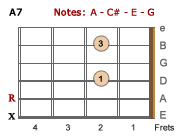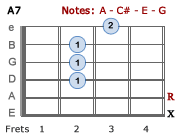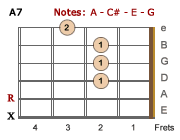A7 guitar chords
A - C# - E - GA7 chords are dominant four-note chords which are derived from the A Major Scale.
- Construction: root, a major third, a perfect fifth and a minor seventh.
- A Major Scale: A - B - C# - D - E - F# - G#
- Chord: A7
- Formula: 1 - 3 - 5 - ♭7
- Notes: A - C# - E - G
A7 - A seventh (1-3-5-b7)
Spelling: 1st(A), 3rd (C#), 5th(E), b7th(G)
Chart Legend
Numbered Circles: number inside circle indicates which finger to useX: Don't play string
White Numbered Circles: Optional Notes
X on string with optional note: if you omit the note, don't play string
Unmarked strings: Play open
Barre Line: One finger holds down multiple strings
R: Root Note
TAB: Numbers represent frets - not finger positions
Blank Strings: Do not Play
0: play string open

Written: x02020
Notes: x-A-E-G-C#-E
Form/chord shape: A7

TAB e |-0-| B |-2-| G |-0-| D |-2-| A |-0-| E |---|

Written: x-0-2-2-2-3
Notes: x-A-E-A-C#-G
Form/chord shape: A

TAB e |-3-| B |-2-| G |-2-| D |-2-| A |-0-| E |---|

Written: 575655
Notes: A-E-G-C#-E-A
Form/chord shape: E7

TAB e |-5-| B |-5-| G |-6-| D |-5-| A |-7-| E |-5-|

Written: x(12)-12-11-12-10-0
Notes: x(E)-A-C#-G-A-E
Form/chord shape: C7

TAB e |-0--| B |-10-| G |-12-| D |-11-| A |-12-| E |(12)|
↓ A7 Guitar Chords
Don't play the 6th string - bottom E?
Why don't we play the bottom E in the A7 chord - 1st position? This topic is explained in detail on the A major chords page. If you are unsure about the following, please read the information on that page before reading on...
The A7 chord is made up of the notes A - C# - E - G (1st - 3rd - 5th - ♭7). If we look at the scale degrees of each note, we have the tonic (1st scale degree), the mediant (3rd scale degree), the dominant (5th scale degree), and the leading tone (7th scale degree).
Remember that the tonic and dominant are the strongest notes in a diatonic scale, with the leading tone adding credence to the tonic, while the mediant is one of the weakest notes.
There are 2 ways of playing A7 in the first position. One avoids the bottom E string, while the other allows it... interesting. Let's analyze both chords:1. A - E - G - C# - E ... looks good with a 1:1:2:1 ratio. We lead with the tonic, 1 mediant, 2 dominants and a leading tone.
There is one more dominant note than tonic. The reason the chord sounds fine, is that there is a leading tone (7th note) in the mix which melodically has a strong affinity for the tonic and leads to the tonic. To the ears, this negates the overwhelming power of the extra dominant note, adding strength of the tonic.
If we play the Bottom E, the chord would read E - A - E - G - C# - E with a 1:1:3:1 ratio... there is one dominant too many with a tendency to spoil the chord. You will hear this when you strum all 6 strings.
2. E - A - E - A - C# - G ... nice with a 2:1:2:1 ratio, with 2 tonics, 1 mediant, 2 dominants, and 1 leading tone. This nice spread gives the chord strength and stability. You will notice this when you play it.
The 2nd and 3rd position chords all have a nice ratio of notes with 2-3 tonic or root notes in each chord.
The 2nd position A7 can also be played omitting the 4th finger and optional note... 575655 (A-E-G-C#-E-A). This still provides a nice balance and is commonly used - very easy to play especially from A barre on the 5th fret to A7 by just lifting the 4th finger.
General rule of thumb for making up your own 4-note chords:
- Analyze the chord and see the ratio of tonic : mediant : dominant : leading-tone. It's always nice to have a fairly even mix.
- Lead with the tonic or root note of the chord wherever possible.
- If that isn't possible, lead with the dominant or 5th note of the chord.
- Remember that the leading tone (7th note) has a strong affinity for the tonic.
- Let your ears decide. Any musician can hear if a chord doesn't sound right. If you are making up your own chords, and it sounds unbalanced, analyze the chord and make sure there is a healthy balance, and make the appropriate changes.
Chord Facts
- An A7 chord is a dominant seventh chord, which means it is made up of the 1st, 3rd, 5th, and b7 notes of the A major scale.
- The notes of an A7 chord are A, C#, E, and G.
- Can be played in many different positions on the guitar, piano, and other instruments.
- A versatile chord that can be used in a variety of different genres of music, including jazz, blues, and rock.
- Often used to create a sense of tension or suspense, but it can also be used to create a sense of excitement or drive.
- Often used as a leading chord, meaning that it leads to another chord, usually the tonic chord.
- Sometimes called the "devil's chord" because of its dark and dissonant sound.
- Was used extensively in blues music, and it is still a popular chord in blues music today.
- A popular chord in jazz music, and it is often used to create a sense of swing.
- Relatively rare chord in pop music, but it can be used to add a sense of tension or excitement to a pop song.
